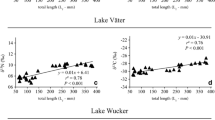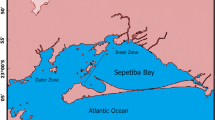Synopsis
A comparative study of the diets of five year classes of perch in Lake Opinicon showed Year class 0 to be mainly Cladocera feeders, the Year class 11 to take a diversified range of insect larvae, whereas from Year class V onwards Anisoptera nymphs, decapods, and fish dominated the diet. Sizes of the dominant food items changed strikingly with growth, prey weights of 0.1, 0.5–1.0, and 100–250 mg predominating in these three age groupings. There were marked month to month changes in types and proportions of different prey consumed.
Overall and month to month feeding overlaps between consecutive year classes were considerable, most values ranging from 0.68–1.0 by the Levins formula. However, diet overlap dropped sharply with increasing age gap.
Month to month dietary changes and year class differences were interpreted relative to benthic invertebrate abundance cycles. Months of increased diet overlap were characteristically those when favored prey types peaked, thereby simultaneously attracting several year classes to them. Hence increased diet. overlap is not necessarily an indicator of increased intraspecific competition.
Habitat differences between the year classes of perch in Lake Opinicon were partial and concerned mainly the smaller, and larger, fish relative to those in the middle size range.
Similar content being viewed by others
References cited
Alm, G. 1946. Reasons for the occurrence of stunted fish populations with special regard to the perch. Reports from the Swedish State Institute of Fresh-Water Fishery Research, Drottningholm 25: 146 pp.
Carlander, K. D. 1953. First supplement to handbook of freshwater fishery biology. Wm. C. Brown, Dubugue, Iowa, pp. 277–429.
Clady, M. D. 1974. Food habits of yellow perch, smallmouth bass and largemouth bass in two unproductive lakes in Northern Michigan. Amer. Midl. Nat. 91: 453–459.
Clemens, W. A., J. R. Dymond, N. K. Bigelow, F. B. Adamstone & W. J. K. Harkness. 1923. The food of Lake Nipigon fishes. Univ. Toronto Stud., Biol. Ser. No. 22, Pub. Ont. Fish. Res. Lab. 16: 171–188.
Coble, D. W. 1966. Dependence of total annual growth in yellow perch on temperature. J. Fish. Res. Board Can. 23: 15–20.
Cooper, W.E. 1965. Dynamics and production of a natural population of fresh-water amphipod, Hyallela azteca. Ecol. Monogr. 35: 377–394.
Couy, E. M. 1935. Fish food studies of a number of Northeastern Wisconsin lakes. Trans. Wis. Acad. Sci. Arts, and Lett. 29: 131–172.
Eschmeyer, R. W. 1937. Some characteristics of a population of stunted perch. Papers Michig. Acad. Sci., Arts & Lett. 22: 613–628.
Ewers, L. A. 1933. Summary report of Crustacea used as food by the fishes of the western end of Lake Erie. Trans. Am. Fish. Soc. 63: 379–390.
Fortin, R. & E. Magnin. 1972. Croissance en longueur et en poids des perchaudes Perca flavescens de la Grande Anse de file Perrot au lac Saint-Louis. J. Fish Res. Board Can. 29: 517–523.
Gibson, C. G. M.1974. Seasonal abundance of Cladocera and Copepoda in L. Opinicon. B. Sc. Thesis, Queen's University, Kingston, Ontario: 65 pp.
Harker, J. M. 1976. Prey selection relative to availability and size: a comparison of the feeding of four inshore fish assemblages in Lake Opinicon, Ontario. M. Sc. Thesis, Queen's University, Kingston, Ontario: 152 pp.
Hasler, A. D. & J. E. Bardach. 1949. Daily migrations of perch in Lake Mendota, Wisconsin. J. Wildl, Mgt. 13: 40–51.
Hunt, B. D. & W. F. Carbine. 1951. Food of young pike. Esox lucius L., and associated fishes in Peterson's ditches. Houghton Lake, Michigan Trans. Amer. Fish. Soc. 80: 67–83.
Jobes, F. W. 1952. Age, growth, and production of yellow perch in Lake Erie. Fisheries Bull. 70: 204–266.
Joeris, L. S. 1957. Structure and growth of scales of yellow perch of Green Bay. Trans. Am. Fish. Soc. 86: 169–194.
Keast, A. 1965. Resource subdivision amongst cohabiting fish species in a bay, Lake Opinicon, Ontario. Proc. 8th Cow, Gt. Lakes Res.: 106–132.
Keast, A. 1977. Mechanisms minimizing intraspecife competition in vertebrates, with a quantitative study of the contrasting strategies of two centrarchid fishes, Ambloplites rupestris and Lepomis macrochirus. Evolutionary Biology, in press.
Keast, A. & L. Welsh. 1968. Daily feeding periodicitics. food uptake rates, and dietary changes with hour of day in sonic lake fishes. J. Fish. Res. Board Can. 25: 1133–1144.
Kutkuhn, J. H. 1955. Food and feeding habits of some fishes in a dredged Iowa Lake. Proc. Iowa Acad. Sci. 62: 576–588.
Laarman, P. W. & J. C. Schneider 1972. The food and feeding habits of the bluegill and yellow perch in lakes with good and poor fishing. Michigan Dep. Nat. Res. Res. Dev. Rep. 279: 1–29.
Langford, R. R. & W. R. Martin. 1940. Seasonal variations in stomach contents and rate of growth in a population of yellow perch. Trans. Amer. Fish. Sec. 70: 436–440.
Lawler, G. H. 1953. Age, growth, production and infection with Trianophorus nodulosus of the yellow perch, Perca flavescens (Mitchill) of Manitoba. Fish. Res. Board Can. MS Rep. Biol. Sta. 521: 1–19.
Le Cren, L. D. 1958. Observations on the growth of perch (Perca fluviatilis L.) over twenty-two years with special reference to the effects of temperature and changes in population density. J. Animal. Ecol. 27: 287–334.
Levins, R. 1968. Evolution in changing environments. Princeton Univ Press, Princeton, New Jersey, pp. 41–52.
May, R. M. 1975. Some notes on estimating the competition matrix. Ecology 56: 737–741.
Mraz, D. 1951. Movements of yellow perch marked in Southern Green Bay, Lake Michigan Trans. Am. Fish. Soc. 81: 150–161.
Nakashima B. S. & W. C. Leggett. 1975. Yellow perch. (Perca flavescens) biomass responses to different levels of phytoplankton and benthic biomass in Lake Memphremagog, Quebec-Vermont. J. Fish. Res. Board Can. 32: 1785–1797.
Northcote, T. C. 1954. Feeding of two Cottus Copeia 1954: 25–28.
Parsons, J. W. 1950. Life history of the yellow perch, Perca flavescens (Mitchill) of Clear Lake, Iowa. Iowa State I. Sci. 25: 83–97.
Pearse, A. S. & H. Achterberg. 1920. Habits of yellow perch in Wisconsin lakes. Bull. Bur. Fish. (Wash.) 36: 295–366.
Pycha, R. L. & L. L. Smith, Jr. 1955. Early life history of the yellow perch, Perca flavescens (Mitchell), in the Red Lakes, Minnesota. Trans. Amer. Fish Soc. 84: 249–260.
Rosenbery, D. A. 1951. Fishery management of Clayton Lake, an impoundment on the New River in Virginia. Trans. Amer. Fish. Soc. 80: 194–209.
Shelbourne, J. E. 1962. A predator-prey size relationship for plaice larvae feeding on Oikopleura. J. Mar. Biol. Assoc. U.K. 42: 243–252.
Sheri, A. N. & G. Power. 1969. Fecundity of the yellow perch, Perca flavescens (Mitchell) in the Bay of Quinte, Lake Ontario. Canadian J. Zool. 47: 55–58.
Siefert, R. E. 1972. First food of larval yellow perch, white sucker, bluegill, emerald shiner, and rainbow smelt. Trans. Amer. Fish. Soc. 101: 219–225.
Stroud, R. H. 1955. Fisheries report for some central eastern, and western Massachusetts lakes, ponds and reservoirs, 1951–1952. Massachusetts Division of Fisheries and Game, Boston: 447 pp.
Tarby, M. J. 1974. Characteristics of yellow perch cannibalsim in Oneida Lake and the relation to first year survival Trans. Am. Fish. Soc. 103: 462–471.
Tharrott, R. C. 1959. Food of yellow perch, Perca flavescens (Mitchell) in Saganaw Bay, Lake Huron. Trans. Amer. Fish. Soc. 88: 330–331.
Walker, E.M. & P.S. Corbett. 1975. The Odonata of Canada and Alaska 3: 1–307.
Webster, D. A. 1942. The life histories of some Connecticut fishes. A fishery Survey of important Connecticut lakes. Conn. State Pub. Doc. No. 47, Bull. 63: 122–207.
Werner, E. F. 1974. The fish size, prey size, handling time relation in several sunfishes and some implications. J. Fish. Res. Board Can. 31: 1531–1536.
Author information
Authors and Affiliations
Rights and permissions
About this article
Cite this article
Keast, A. Diet overlaps and feeding relationships between the year classes in the yellow perch (Perca flavescens). Environ Biol Fish 2, 53–70 (1977). https://doi.org/10.1007/BF00001416
Received:
Accepted:
Issue Date:
DOI: https://doi.org/10.1007/BF00001416




